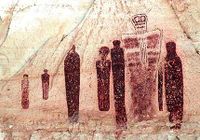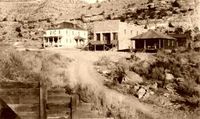Sego Canyon Cave Paintings: Difference between revisions
No edit summary |
No edit summary |
||
| Line 12: | Line 12: | ||
==Fremont Tribe== | ==Fremont Tribe== | ||
From approximately 600-1250 A.D. the Sego Canyon was occupied by the Fremont Native Tribe. Named after the Fremont river and valley were most of their site were discovered, the Fremont tribe was one closely tied to nature with their hunting, gathering, and farming lifestyle. They lived in pit houses, created pottery and rock art that is distinguishable by the rectangular or trapezoidal bodies and small heads.<ref name="Holloway" /> | From approximately 600-1250 A.D. the Sego Canyon was occupied by the Fremont Native Tribe. Named after the Fremont river and valley were most of their site were discovered, the Fremont tribe was one closely tied to nature with their hunting, gathering, and farming lifestyle. They lived in pit houses, created pottery and rock art that is distinguishable by the rectangular or trapezoidal bodies and small heads.<ref name="Holloway" /> They are quite different as their lifestyle is more sedentary than that of most other tribes. The Fremont tribe culture has all but disappeared and many changes that occured are to blame. Due to the climate, farming conditions had changed dramatically forcing groups to forage for food from the land and, as new settlers migrated the Fremont tribe slowly vanished.<ref name="Fremont Indians">Fremont Indians. (n.d.). Retrieved from https://www.nps.gov/grba/learn/historyculture/fremont-indians.htm.</ref> | ||
==Barrier Canyon== | ==Barrier Canyon== | ||
| Line 21: | Line 21: | ||
==Anasazi Tribe== | ==Anasazi Tribe== | ||
The Anasazi tribe occupied the land as early as 1500 B.C. building villages from mud and stone and miles of road. They scaled the cliffs to build some of the magnificent structures, some 5 stories high. | The Anasazi tribe occupied the land as early as 1500 B.C. building villages from mud and stone and miles of road. They scaled the cliffs to build some of the magnificent structures, some 5 stories high. As many as 30,000 lived there at one time creating the petroglyphs and beautiful pottery.The Anasazi tribe has survived a great deal, from warfare that caused some cannibalistic periods, to assaults from spanish colonizers. Still the Anasazi tribe has survived one generation after another, today they are descendants of the Taos Pueblo in New Mexico and the Hopi villages in Arizona.<ref name="Roberts">Roberts, D. (2003, July 1). Riddles of the Anasazi. Retrieved from https://www.smithsonianmag.com/history/riddles-of-the-anasazi-85274508/.</ref> | ||
[[File:anasazi.jpg|200px|thumb|right|Chaco Canyon<ref name="Aadelia">Aadelia. (1970). American Seeker Anasazi Chaco Canyon. Retrieved from http://antiquescollectables4089.blogspot.com/2012/03/american-seeker-anasazi-chaco-canyon.html.</ref> | |||
Revision as of 16:55, 27 November 2019
By Devon Washington

Sego Canyon Cave paintings are a group of more than 80 figures suggested to depict ancient astronauts or extraterrestrials that once visited the Earth when the multiple Native American tribes lived in this area.
Background
History of Sego
Sego Utah started off in the early 1890s as farmer Harry Ballard discovered coal on the lands next to his ranch. He then began purchasing this land to begin small scale coal mining operations that eventually rose to a small community named Ballard, after the owner.

Ballard’s property was eventually bought out and the American Fuel Company began to develop the area in 1911 with plans for long-term coal production. Over time the company was plagued with water system problems, low profits, power supply issues and overall financial problems. At some points, there was no money to pay the miners, they were given scripts to spend at the company store. In 1949 a fire swept the site, drastically decreasing productions. Then when diesel engines mostly replaced coal powered steam engines the company came to a halt. After this, Sego became a ghost town.[2]
Fremont Tribe
From approximately 600-1250 A.D. the Sego Canyon was occupied by the Fremont Native Tribe. Named after the Fremont river and valley were most of their site were discovered, the Fremont tribe was one closely tied to nature with their hunting, gathering, and farming lifestyle. They lived in pit houses, created pottery and rock art that is distinguishable by the rectangular or trapezoidal bodies and small heads.[1] They are quite different as their lifestyle is more sedentary than that of most other tribes. The Fremont tribe culture has all but disappeared and many changes that occured are to blame. Due to the climate, farming conditions had changed dramatically forcing groups to forage for food from the land and, as new settlers migrated the Fremont tribe slowly vanished.[3]
Barrier Canyon
The Barrier Canyon rock art was created by the Archaic people around 6000 B.C.-100 B.C. consisting of large manlike forms. Often these forms were missing legs or arms, had hollowed eyes, wore antennae-like earrings, and carried snakes. Figures like these may depict the ritualistic activities that took place amongst these people.[1]
Ute Tribe
From approximately 1300 A.D. –1880 A.D. the Ute Native tribe occupied the Sego Canyon area until being forced to live on reservations in 1880. The Ute tribe rock art can e identified by the horse riding figures, as horses weren’t introduced until the 16th century by the Spanish.[1]
Anasazi Tribe
The Anasazi tribe occupied the land as early as 1500 B.C. building villages from mud and stone and miles of road. They scaled the cliffs to build some of the magnificent structures, some 5 stories high. As many as 30,000 lived there at one time creating the petroglyphs and beautiful pottery.The Anasazi tribe has survived a great deal, from warfare that caused some cannibalistic periods, to assaults from spanish colonizers. Still the Anasazi tribe has survived one generation after another, today they are descendants of the Taos Pueblo in New Mexico and the Hopi villages in Arizona.[4]
[[File:anasazi.jpg|200px|thumb|right|Chaco Canyon[5]
Pseudo-archaeological Narrative
The ancient astronaut theory attached to this site suggests that extraterrestrials visited the Earth and the rock art figures are evidence, claiming the larger odd figures with hollowed eyes or triangular heads cannot possibly be human.
This narrative does not account for the spiritual component at the root of Native American art. If these theories were true we would see more depictions of it rather than unclear, possible unearthly, forms.
Debunking the Pseudo-archaeological Claims
Shamanism
Shamanism among Native cultures is quite common. Shamins are persons skilled in the assistance of multiple spirits, including animals. Through trance and symbolic death they have abilities allowing them to travel to celestial realms in order to communicate with higher powers. All things, plants, animals and people, are seen as equal and able to assume one anothers' forms.
Conclusion
While some can believe that the Sego Canyon rock art is evidence of ancient aliens, cultural aspects of the communities that once lived there disprove this narrative. Native shamans more than likely created these works of art to explain their visions and religious
References
- ↑ 1.0 1.1 1.2 1.3 Holloway, A., (2014)."extra-terrestrials or spiritual visions?" Retrieved from https://www.ancient-origins.net/ancient-places-americas/haunting-rock-art-sego-canyon-extra-terrestrials-or-spiritual-visions-001584.
- ↑ 2.0 2.1 "Legends of America." (n.d.). Retrieved from https://www.legendsofamerica.com/ut-segocanyon/.
- ↑ Fremont Indians. (n.d.). Retrieved from https://www.nps.gov/grba/learn/historyculture/fremont-indians.htm.
- ↑ Roberts, D. (2003, July 1). Riddles of the Anasazi. Retrieved from https://www.smithsonianmag.com/history/riddles-of-the-anasazi-85274508/.
- ↑ Aadelia. (1970). American Seeker Anasazi Chaco Canyon. Retrieved from http://antiquescollectables4089.blogspot.com/2012/03/american-seeker-anasazi-chaco-canyon.html.